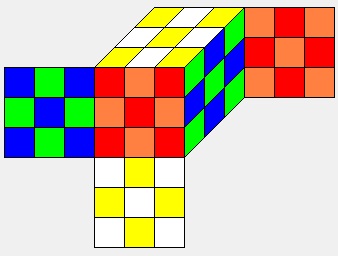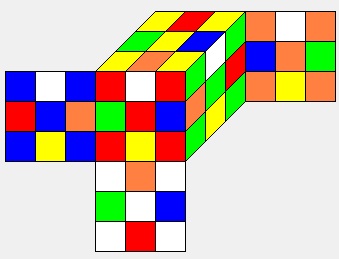The name Pons Asinorum literally means "Bridge
of Asses". The name is used in many fields of endeavor to denote
a problem that is considered so easy that if you cannot hack it, you are
a dunce in the field and you should find another field. The most
common example is geometry, where the Pons Asinorum problem is Euclid,
Book 1, Proposition 5, which states that the base angles of an isosceles
triangle are equal. For Rubik's Cube, the Pons Asinorum problem is
the checkerboard pattern where the corner cubies are fixed and where all
the edge facelets have the color of their respective opposite faces.
There is great flexibility in maneuvers for
the Pons Asinorum. For example, F commutes with B, so that we may
write the syllable (FFBB) as any of (FFBB), (FBFB), (FBBF), (BBFF),
(BFBF), or (BFFB). A syllable is defined as any sequence of
quarter turns or face turns of the same or opposite faces. All the
moves within a syllable commute with each other.
As another example of the flexibility of
maneuvers for the Pons Asinorum, FFBB,
LLRR, and UUDD are M-conjugate
syllables and Symm(Pons)=M. Because Symm(Pons)=M, we may take any
M-conjugate of the maneuver without changing the position.
And because the syllables FFBB, LLRR, and UUDD are M-conjugate with each
other, many of the M-conjugates of the maneuver effectively commute the
syllables. So such things as (UUDD)(LLRR)(FFBB) are alternative
maneuvers for the Pons. In fact, the three syllables for the maneuver
may be commuted in any way in which you wish and you will still have a
maneuver for the Pons Asinorum.
Finally, we may take inverses for all of
the quarter turns for any or all of the faces, for example F'F'BB or F'F'B'B'
replacing FFBB.
So many people have discovered the Pons Asinorum
independently and it is so simple that I do not know who discovered it
first. The first mention of it in Cube-Lovers was by yekta@mit-mc
(name unknown, E-mail address almost certainly no longer valid) on 17 July
1980. Bernard S. Greenberg
provided what is considered the standard
maneuver on the same date. Both yekta and
Greenberg called the maneuver
a checkerboard rather than the Pons Asinorum. Later the same day,
Greenberg called the position the
Pons Asinorum, and also pointed out that
there are other checkerboard patterns that are not the Pons Asinorum.
Dan Hoey first reported to Cube-Lovers that
12q and 6f maneuvers were minimal on 7 January 1981. He attributed
the proof to Alan Wechsler
(sent to him by David C. Plummer) and to Chris
C. Worrell.
The proof is roughly as follows. In
the Pons Asinorum position, each edge cubie is 4 quarter turns from home.
There are 12 edge cubies, so the edge cubies are collectively 48 quarter
turns from home. A quarter turn moves 4 edge cubies, so that one
quarter turn can at most reduce the collective number of quarter turns
away from home for the edge cubies by 4. Therefore, at least 12 quarter
turns are required to solve the Pons Asinorum. This fact, along with
the existence of solutions that are 12q and 6f in length, shows that 12q
and 6f are minimal.
In another Cube-Lovers article on 7 July
1981, Hoey
gave a totally different maneuver for Pons Asinorum, namely
(UD'FB')3 or (UD'FB')(UD'FB')(UD'FB'), accomplishing the Pons
Asinorum with 6 slice moves.
In a Cube-Lovers article on 19 February 1995,
Jerry Bryan
reported the results of a computer search that showed that
there are five positions unique up to symmetry that are halfway positions,
6q from Start and 6q from Pons Asinorum.
-
Three of the halfway positions differ only in
commuting the moves within a syllable or in using counterclockwise moves
within a syllable instead of clockwise moves. Hence, they correspond
to only a single distinct maneuver for the Pons Asinorum, namely the one
that is usually viewed as the "standard" maneuver.
-
The fourth halfway position is halfway through
Hoey's sequence of
6 slice moves, which is a second distinct maneuver
for the Pons Asinorum.
-
The fifth halfway position is halfway through
the following maneuver, yielding a third distinct maneuver for the Pons
Asinorum: (FB')(RRLL)(UUDD)(FB'). The third maneuver was identified
on 20 February 1995 by der Mouse, based on an analysis of the fifth halfway
position.


 FF BB LL RR UU DD 12q
FF BB LL RR UU DD 12q
 R'UUBL'FU'BDFUD'LDDF'RB'DF'U'B'UD' (24q)
R'UUBL'FU'BDFUD'LDDF'RB'DF'U'B'UD' (24q)
